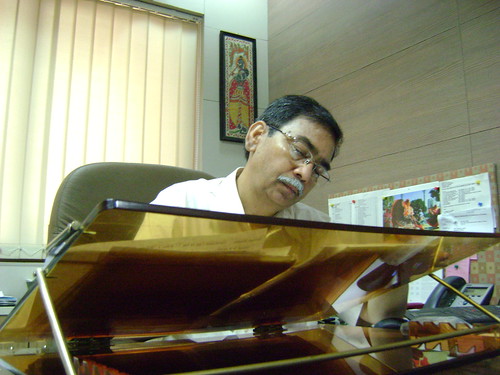By Kashif-ul-Huda, TwoCircles.net
Naveen Joshi has been associated with journalism for the last 30 years. He has seen the growth of Hindi newspapers from being a poor cousin of English print media to a position of power and influence. Read by crores of Indians every day, content and look of a Hindi newspaper today reflects the aspirations of the reader but still they have yet to become a complete newspaper, feels Naveen Joshi, who is the Editor of Hindi daily Hindustan. Some exercpts from his interview last year with Kashif-ul-Huda of TwoCircles.net:
Changes in Hindi newspaper coverage:
Indian middle class is going through a big change, aspirations of these readers who want to move ahead in life is reflected in Hindi newspapers. Lifestyle, eating habits, reading habits and a different political climate is all covered by Hindi newspapers of today.

Naveen Joshi is the Executive Editor of Hindustan Dainik for Uttar Pradesh. [TCN Photo]
Reporting issues concerning caste and religious groups:
For example, when Muslims came under pressure on terrorism charges especially Muslims of Azamgarh we sent a reporter there for few days to understand the pain of being Muslims in today’s world.
Similarly, Dalits are treated very poorly, even though a Dalit leader Mayawati is the chief minister of the state. Fortunately, I work in a newspaper where I can raise these issues of equality, terrorism, communalism, and casteism. So, everyone wants to condemn the politics of caste but we try to understand the reasons for this politics and also explain that it is needed to a certain extent to bring lower castes community at par with other social groups.
Women also have their own identity and the language that we use now is sensitive to these issues.
Covering Muslim issues:
I do not claim that we cover all Muslim issues adequately. In our team, in media, there are very few people who understand Muslim issues or Dalit issues. It is one thing to have sympathy but how to write about them accurately is a challenge. Even now, our reporting on Muslims is focused on their festivals like Eid and Prophet’s birthday. When we write on Muslim topics, we write with caution because when we write on Islam or say something based on Quran then we get criticized. So we try to avoid those topics or at least not deal with them head-on.
Hinduization of Hindi newspapers:
We use imagery from Indian mythology to popularize our content. Yes, some of the images we use are from Hindu traditions and I can understand why someone might object but we have to be a bit liberal about its usage. Islam is also part of Indian culture but many times Hindu images will get used but I don’t think it is such a big issue.
Impact of TV channels and internet on Hindi newspapers:
Hindi and other language newspapers are still increasing their readership because of increasing literacy in villages. In urban areas, the power of printed words is still there. More importantly, newspapers still performs the job of opinion makers which TV news is not able to do. We, the language media, don’t feel electronic media is our competition since our society at this time needs opinions, ideas, views and dissent that seems to be missing from electronic media. So I don’t see any threat from TV news or internet news for the next 10-20 years.
Challenges of a daily newspaper when news is accessible 24/7:
See, take the example of the last Lok Sabha election results. Everyone knew the results but still order for the next day issue of our newspaper increased by 11,000. So more people wanted to read the newspapers to read our analysis of the results, to understand the reasons for the result as it turned out.
Secondly, electronic media is still not able to capture news from small towns and remote districts. Those news you can find only in language newspapers.
Recognition to Hindi media:
Till ten years ago, Hindi journalists were not given due recognition, they were made to wait or returned back while English journalists were given prompt interviews but this is not the case anymore. Now, opinion-makers, decision-makers, and highest officials in the government read Hindi newspapers first and then English newspapers. Hindi newspapers in Hindi heartland are taken seriously.
Hindi journalism of today:
We do all what any English newspapers will do. In fact, now English newspapers follow our lead because they do not have the same penetration that we have in the society. We have a concept of “preparation” i.e. prepare our readers for future by telling them how to take care of health, teach them about new technologies, religion, personal finance. The idea is to prepare them about what is to come in future, this is something unique to us and you won’t find that in an English newspaper. But we are also rooted in the present and run various series, e.g. on agriculture.
Covering international news:
Hindi newspapers continue to be highly localized. They usually do not have much national or international news. And if you look at district editions they do not have news from even other districts of the same state. But now situation is changing and there are attempts to include more national and international news and to become a complete newspaper.
On Hindi writing:
Thirty years ago there was much emphasis on the language. Our editors used to tell us that a journalist should have command over language so that he can easily communicate with readers. Now, our Hindi is corrupted. Hindi grammar has been replaced with English grammar. Newspaper language has become difficult, got removed from the public, and distant from original Hindi.
Naveen Joshi is also a creative writer and has published three books:
1. Apne morche par [short story collection]
2. Rajdhani ki shikar katha [short story collection]
3. Dawanal [novel]: based on Chipko movement in Uttarakhand.
Full interview in video
Link:
http://epaper.hindustandainik.com/

